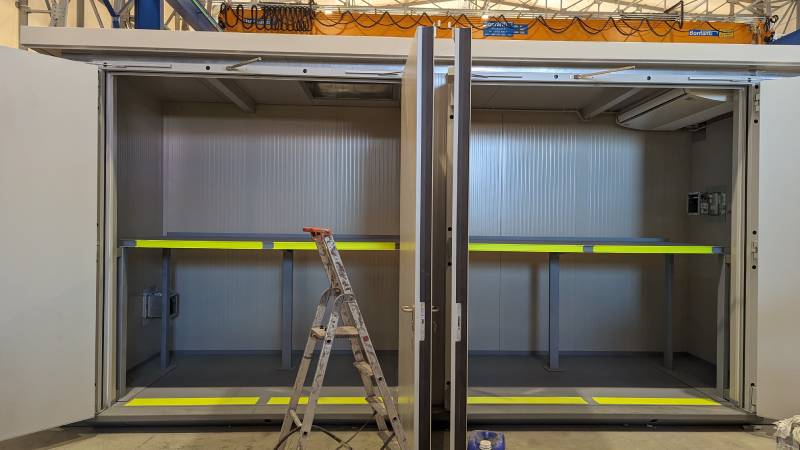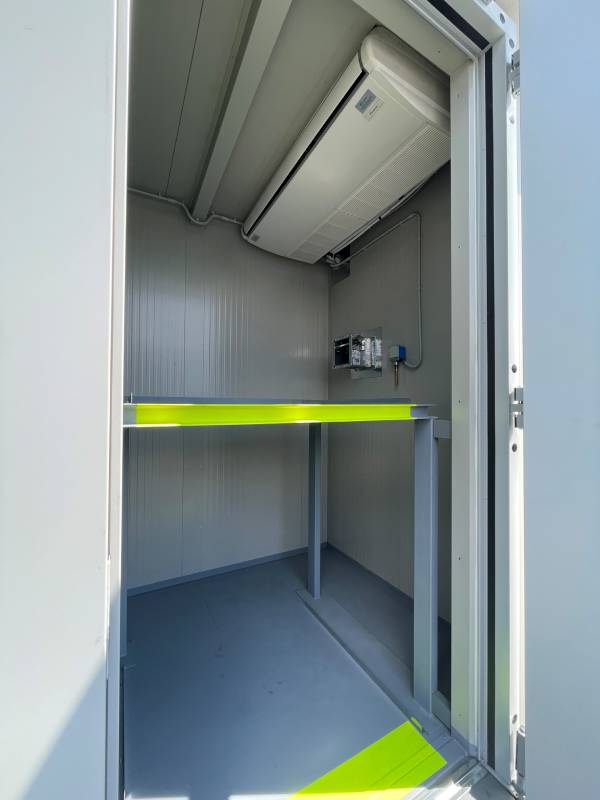Shelter for Lithium Battery Storage
A “shelter” for lithium battery storage is a unit or system specifically designed to safely house and protect lithium batteries. Lithium batteries have become increasingly popular in recent years due to their high energy density and the ability to store large amounts of energy in a small space.
Lithium batteries can pose safety concerns such as overheating, fire, or explosion under certain circumstances. Therefore, safe storage of lithium batteries is of paramount importance, especially when working with large quantities of batteries or in sensitive environments.
A shelter for lithium battery storage offers a range of features designed to ensure safety during storage. Some common features include:
- Fire-resistant materials: The shelter is constructed with fire-resistant materials to reduce the risk of fire propagation.
- Ventilation system: An adequate ventilation system helps maintain the internal temperature of the shelter within safe limits, reducing the risk of battery overheating.
- Gas detection: lithium batteries during storage can release gases, which can be detected by special detector so that they can be promptly dispersed before they become concentrated in hazardous atmospheres.
- Automatic extinguishing systems: Some shelters may have automatic extinguishing systems that use fire suppression agents such as foam or inert gas to control and extinguish fires.
- Impact protection: The shelter may have a robust and impact-resistant design to protect batteries from mechanical damage that could compromise safety.
- Environmental control: Some shelters may have environmental control systems, such as humidity and temperature control, to create ideal storage conditions for the batteries.
It is important to note that the exact specifications of a shelter for lithium battery storage may vary depending on local regulations and specific application requirements. It is crucial to adhere to safety guidelines and existing regulations to ensure proper storage of lithium batteries and mitigate potential risks.

The lithium battery storage shelters produced by Sogese, available for both purchase and rental, are REI120 certified and comply with the ATEX directive.
Fire risk classification in workplaces is defined within the DM March 10, 1998 (Decree in update), which regulates the classification, as provided in Art. 28 and in accordance with Art. 46 and 62 of Legislative Decree No. 81/2008. Companies can be classified into 3 different fire risk categories: low, medium and high.
ATEX refers to a set of standards and directives that regulate the design, installation, and use of equipment and systems in potentially explosive environments. The term “ATEX” is derived from the combination of two European directives: Directive 2014/34/EU, known as ATEX 114, which pertains to electrical and mechanical equipment used in explosive atmospheres, and Directive 1999/92/EC, known as ATEX 153, which focuses on the protection of workers operating in such environments.
ATEX directives were introduced to ensure a high level of safety in potentially explosive environments where the presence of flammable substances such as gases, vapors, mists, or combustible dust could cause explosions or fires. Potentially explosive environments can be found in various industrial sectors such as petrochemical, chemical, pharmaceutical, food, and manufacturing.
ATEX requires that the equipment and systems used in such environments are designed, constructed, and installed in accordance with specific safety standards. Some key points of ATEX include:
- Classification of hazardous zones: ATEX categorizes areas based on the likelihood of an explosive atmosphere being present, and it provides guidelines for the selection of suitable equipment for each zone.
- Equipment and protective systems: ATEX sets out requirements for the design and construction of equipment and protective systems to ensure their safety and prevent the ignition of potentially explosive atmospheres.
- Marking and labeling: ATEX specifies that equipment intended for use in potentially explosive atmospheres must be clearly marked and labeled with relevant information, including the equipment’s group, category, and temperature class.
- Risk assessment: ATEX emphasizes the importance of conducting a thorough risk assessment to identify potential sources of ignition and implement appropriate control measures.
By following the principles and requirements of ATEX, companies can minimize the risks associated with working in potentially explosive environments and ensure the safety of their personnel and facilities.
 The REI120 classification refers to the fire resistance characteristics of a construction element, such as a wall, door, or ceiling, and is used in the context of fire safety. The acronym “REI” stands for “Resistance, aErmeticity, Isolation” (Resistance, Exercise, Insulation), and the number “120” represents the fire resistance period expressed in minutes, which corresponds to two hours in the case of the REI120 classification.
The REI120 classification refers to the fire resistance characteristics of a construction element, such as a wall, door, or ceiling, and is used in the context of fire safety. The acronym “REI” stands for “Resistance, aErmeticity, Isolation” (Resistance, Exercise, Insulation), and the number “120” represents the fire resistance period expressed in minutes, which corresponds to two hours in the case of the REI120 classification.
The REI120 classification indicates that a particular construction element has been designed and tested to withstand the high temperatures and heat generated by a fire for a period of 120 minutes (two hours) without structural failure, while maintaining its fire resistance and thermal insulation properties.
Construction components classified as REI120 are used to create fire-resistant compartments within a building. These compartments serve to contain and limit the spread of flames, smoke, and heat from one area to another, providing a safe evacuation time and allowing intervention by emergency responders.
Construction elements that meet the REI120 classification are made using special materials and design techniques that give them high thermal and structural resistance. They can include walls, doors, windows, ceilings, and floors that, in the event of a fire, help contain the spread of flames and smoke within a specific area for an extended period of time.
The REI120 classification is often required in public buildings such as hospitals, schools, shopping centers, hotels, and offices, where ensuring the safety of people and protecting structures from fires is crucial. It is important to note that the REI120 classification may vary depending on local regulations and technical specifications of each country.
We are able to provide tailor-made lithium battery storage shelters that comply with the REI120 and ATEX directives. Contact us for more information and a quote.